Text updated 19981004 20011118
Homepage - The Name Skirrow
VISITING THE DEAD DUDES
A Journey into Family History
By Peter J Skirrow
A Sunday Outing in 1905 - my grandfather and other Skirrows
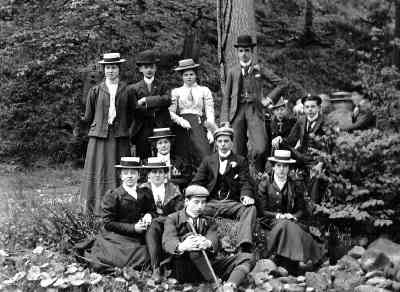 I started an evening class in Genealogy in the
Autumn of 1992. It was something I'd always intended to do one day, if
only to find a better answer to give to the perpetual question, "Skirrow,
that's an unusual name - where does it come from?" Dora Kneebone was an
elderly lady with a fascination for other people's family histories that
fitted her well for her subject. Week by week she told us how to go
through the various stages. Firstly we could use the Mormon records,
then we should visit St Catherine's house, and the office of Population
and Census nearby. She gave us a little map and marked the little cafe
where we could get a sandwich and a cup of tea. Then we could visit
churches and look for gravestones, but if we wanted to see parish records
we must make an appointment with the vicar, whom we should reward suitably
by donating to his church fund. We could aim for a 'total ancestry'
chart, or, in the case of a rare name there was always the 'one name
study'.
I started an evening class in Genealogy in the
Autumn of 1992. It was something I'd always intended to do one day, if
only to find a better answer to give to the perpetual question, "Skirrow,
that's an unusual name - where does it come from?" Dora Kneebone was an
elderly lady with a fascination for other people's family histories that
fitted her well for her subject. Week by week she told us how to go
through the various stages. Firstly we could use the Mormon records,
then we should visit St Catherine's house, and the office of Population
and Census nearby. She gave us a little map and marked the little cafe
where we could get a sandwich and a cup of tea. Then we could visit
churches and look for gravestones, but if we wanted to see parish records
we must make an appointment with the vicar, whom we should reward suitably
by donating to his church fund. We could aim for a 'total ancestry'
chart, or, in the case of a rare name there was always the 'one name
study'.
Mine was a rare name I thought, so I started
by looking it up in the reference books. Most were vague, but one said
that the name probably originated in the village of Sharrow in Yorkshire,
the change from sh to sk being common in Yorkshire because of Viking
influence on the language. That made sense; my dad came from Leeds. I
also spent a few hours in the library going through all the telephone
directories for Britain and copying down every Skirrow entry - a hundred
and fifty in all. I marked them as dots on a map and they centred on
Bradford, with just a scattering as far away as the south coast. That was
just the sort of number for a one-name study.
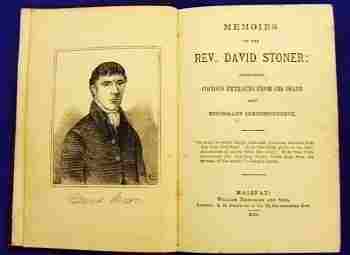
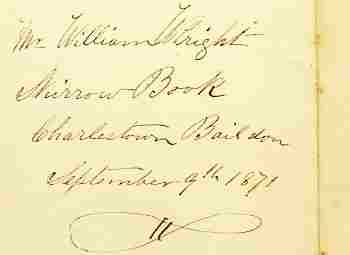
One thing Dora always stressed. "Go to the
women in the family," she would say. " They are the ones who keep things,
and remember." So I asked my mother, but she knew little about the
Skirrow side of the family, and my dad, though still alert and full of
memories, couldn't think why it had never occurred to him to ask about his
grandparents: as far as he knew, he never had any, his dad had just never
talked about his past! Then mam suggested I could look through the old
bookcase in the front room. Grandad had made it, being a cabinet maker
for the Leeds Co-op all his life, and I knew it contained some old books
that had been his. There was 'Uncle Tom's Cabin', and 'Milton's Poems',
and a number of religious books, such as 'Gods Gift to Two', but now I was
looking at the inside covers, and most of them had labels I'd never
noticed before, with inscriptions like 'Albert E Skirrow - 1st prize for
handwriting - Charlestown Wesleyan Society' - that was my grandfather.
One had a curious entry - 'Mr William Wright Skirrow Book' - Charlestown,
Baildon - 1871. I'd never heard of Baildon, but I got out the road atlas
and there it was on the edge of Ilkley moor, not far from Sharrow. Who
could William Wright have been?
Finding names in St Catherine's house proved
tedious without knowing any birth dates, so I set off on the train one day
to visit the census office. The place fascinated me. Just as Dora had
said, it was an underground rabbit warren of corridors and rooms full of
microfilm readers. I put my numbered tag round my neck and set off to
look for the microfilm reader of the same number. Then I looked up
Baildon in an index and found the microfilm number for the latest census
available after the statutory hundred years secrecy - 1891. More
corridors and rooms and I found my microfilm, replacing it with the dummy
from my reader as instructed. What a clever system: if you tried to take
the film back to the wrong cabinet you wouldn't retrieve your dummy
cartridge, and if you found a dummy where the film you wanted should be,
then you knew it was in use. For once I was impressed! Now I could
settle down to my search, street by street, through three thousand
handwritten addresses, looking for Skirrows.
An hour later my eyes were getting tired when
suddenly I got a surprise. Not just one Skirrow, but eight in a row at
two adjacent addresses in Ada Row. Suddenly I was confronted with a
wealth of information I hadn't thought about. There was Albert Ernest, my
grandfather, aged 13 and listed as a 'bobbin pegger', and William Wright,
his father and a widower at 41 was a life assurance agent. Excited by my
findings, I searched the next film - 1881, and then 1871, until my eyes
were blurred and the cabinets were being locked up. A month later, I
completed my search back to the start of the ten-yearly census records in
1841. In several films I found the heading 'Skirrow Houses', followed by
a block of eight houses in Ada Row, all occupied by Skirrows. Ada Row, it
seemed, was home to four generations of Skirrows, all working in the
Worsted weaving mill from the age of twelve, each generation having around
eight children who sometimes married and lived next door, and as I pieced
together their story I began to realise that a subtle change had occurred.
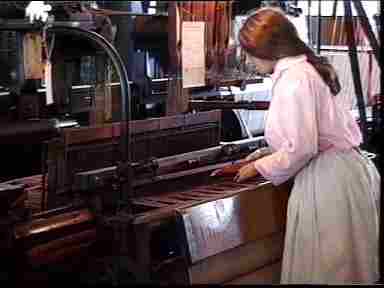
Bradford Industrial Museum
I had started this search for my ancestors
with the aim of collecting names and dates for a tree, but now I was
beginning to know these people and their way of life. I may have been
taught at school that the Victorians had big families and worked long
hours in the Northern mills, but I hadn't really assimilated what that
meant. Now I was reading, in the actual handwriting of that census
collector over a hundred years ago, that my grandad was a bobbin pegger at
twelve - and I was trembling with excitement! Gaining a feel for the
actual lives of my ancestors during the industrial revolution suddenly
seemed far more valuable than trying to trace back my more distant
origins, and endless possibilities for finding out more were revealing
themselves.
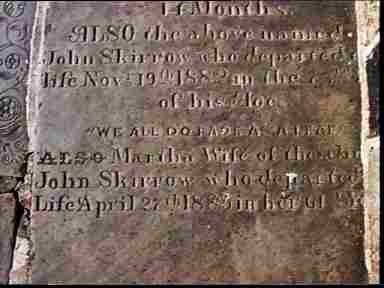
Gravestone of John Skirrow and Family - set in the path at St Johns Church
Baildon
So it was that I
began to visit Baildon, on what was to become a twice yearly pilgrimage
with my two boys and their grandparents. On our first visit we got to
know the little town of Baildon, bought a few books, and found a
gravestone in the path of St Johns church that listed the names of John
Skirrow, my great great grandfather, his two wives and some of his
children.
I contacted Fred Skirrow, from the local
telephone directory, who turned out to have known my dad as a boy, and who
was able to identify several people on a little photograph from my mothers
album, taken in 1905. He also knew where it was taken: Shipley Glen, a
famous beauty spot just a mile from his home.
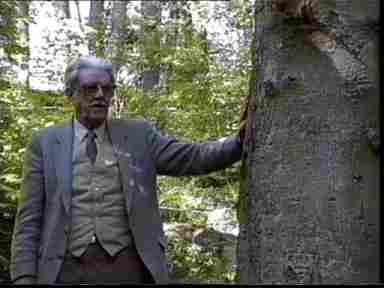
Cliff Skirrow at the Site of the Original Photo
-Shipley
Glen
That photo took on new meaning when I scanned
it into my computer and enhanced it electronically, printing it out on
four A4 sheets which I carefully stuck together. We walked through the
glen, and even found the tree, now somewhat thicker, by which we reckoned
the photo had been taken, and as I look at that photo I feel a very real
link with that former age of hats and watch chains and Sunday
walks.
Our next visit was to look for the former site
of Ada Row (later changed to Ada St). Fred had known it, but now it had
gone he said. He had walked there only the other day and the whole area
had been recently rebuilt with modern houses - what a pity. Arriving in
Baildon, I asked directions at the newsagents shop. . "Oh I think its
still there," said the girl, and we set off for the area by the river
still known as Charlestown. Driving along the straight road we saw the
modern houses, and pulled in to explore on foot. Then we came across it.
"Ada St", said the sign at the entrance to the one little row of stone
cottages.
One side had been demolished, but the other
had been renovated, and yes, there was number 5. A hundred and fifty
years, and it was still there! Its occupants, a young couple, no doubt
wondered at the little group taking photographs of their home, but they
soon became interested in what I had to show them, and invited us to look
round, proudly displaying the old fireplaces that had been covered over
for years until they exposed them. They showed us an old postcard they
had discovered during their work, but it revealed no clues to the former
occupants I now knew so much about. The rooms were quite tiny, with just
a living room and kitchen downstairs, but the walls looked fit to stand
for a long time yet.
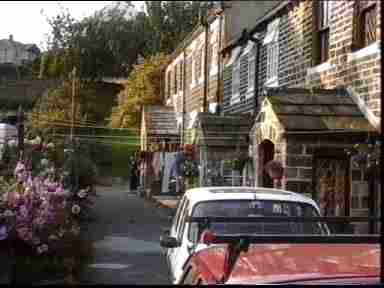
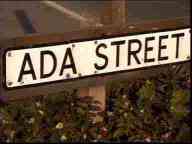
Ada Street Today - Home to Four Generations of
Skirrows
We still make our little trips to Baildon.
'Visiting the dead dudes', the kids call it! Each time we drive up, I try
to include something of more general interest - last year we visited the
Industrial Museum at Bradford, based in an old wool mill, where we saw
working looms and other machines of the type used in the nineteenth
century as well as an exhibition of old cars. Another time we visited
Otley, and stopped for fish and chips at the famous 'Harry Ramsden's' on the way
home. This spring we visited the old Parsonage at Hawarth, home of the
Bronte Sisters.
To keep the boys happy, we started the day at the
National Museum of Photography Film
and Television in Bradford where we watched a spectacular film of
'Yellowstone' on the only giant
'IMAX' system
in Britain - and grandma and grandad were quite taken aback by the screen
five stories high!
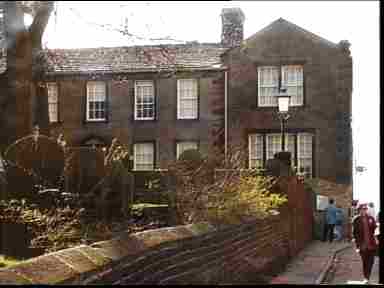
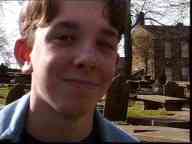
The Parsonage at Howarth - Home of the Bronte
Sisters
I'm sure Chris and Neil will remember these
visits, and that, together with my writings and records they will form a
valuable link with the past in years to come. Who knows, they may find
themselves visiting Ada Street in fifty years time, and looking in awe, as
I do now, at the place where their ancestors lived in that age when
Yorkshire was at the centre of the industrial revolution and world textile
production; when Bradford was home to mechanical innovations that were at
the cutting edge of world technology, and when the Brontes were writing
'Jane Eyre' and 'Wuthering Heights' just a few miles away! Darwin was
just thinking about evolution; and the age of electronics, television and
genetic engineering didn't even figure in the wildest dreams of science
fiction writers! I think my sons have a lot of growing up to do before
they will grasp all that.
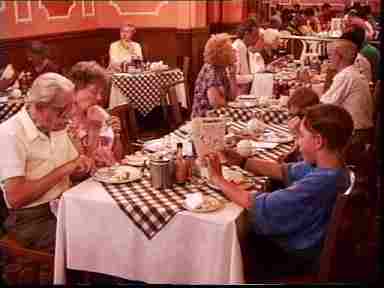
Tea at Harry Ramsden's - The Poshest Chip Shop in the North
©
P J Skirrow 1995
Homepage - The Name Skirrow
The Name Skirrow - My family history
The Skirrows of Baildon - My Skirrow family tree
 I started an evening class in Genealogy in the
Autumn of 1992. It was something I'd always intended to do one day, if
only to find a better answer to give to the perpetual question, "Skirrow,
that's an unusual name - where does it come from?" Dora Kneebone was an
elderly lady with a fascination for other people's family histories that
fitted her well for her subject. Week by week she told us how to go
through the various stages. Firstly we could use the Mormon records,
then we should visit St Catherine's house, and the office of Population
and Census nearby. She gave us a little map and marked the little cafe
where we could get a sandwich and a cup of tea. Then we could visit
churches and look for gravestones, but if we wanted to see parish records
we must make an appointment with the vicar, whom we should reward suitably
by donating to his church fund. We could aim for a 'total ancestry'
chart, or, in the case of a rare name there was always the 'one name
study'.
I started an evening class in Genealogy in the
Autumn of 1992. It was something I'd always intended to do one day, if
only to find a better answer to give to the perpetual question, "Skirrow,
that's an unusual name - where does it come from?" Dora Kneebone was an
elderly lady with a fascination for other people's family histories that
fitted her well for her subject. Week by week she told us how to go
through the various stages. Firstly we could use the Mormon records,
then we should visit St Catherine's house, and the office of Population
and Census nearby. She gave us a little map and marked the little cafe
where we could get a sandwich and a cup of tea. Then we could visit
churches and look for gravestones, but if we wanted to see parish records
we must make an appointment with the vicar, whom we should reward suitably
by donating to his church fund. We could aim for a 'total ancestry'
chart, or, in the case of a rare name there was always the 'one name
study'.








